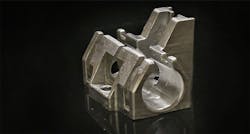Researchers Aim to Produce Titanium Parts in Space
The “EasyTitan” development program announced recently by Germany’s top industrial research organization seems certain to be nicknamed “3D printing in space,” which is what it sets out to achieve. The Fraunhofer Institute for Manufacturing Technology and Advanced Materials (IFAM) in Dresden has the German Aerospace Center e.V. (DLR) as its partner in the project, setting as their goal a rapid and reliable process for manufacturing light-metal aerospace components using additive manufacturing – in space.
Two larger trends are immediately apparent in this, the first being the desire to standardize on-site production of engineered parts. This is the objective of the U.S. Army’s Expeditionary Lab project, which would assemble mold-making, melting, casting, and 3D printing in a compact container or truck, so that it can be moved easily and quickly to a location, such as a combat zone or rescue site. It’s a practical application of the desktop production or maker-space initiatives, and it pushes the logic of custom manufacturing to the practical limits – or perhaps beyond.
The other trend at work is the reevaluation of materials, and development of new materials to serve specific purposes – efforts that often intersect with the custom manufacturing objectives.
If critical parts are needed at a remote location, outer space certainly qualifies as a manufacturing zone. The IFAM and DLR project aims to minimize the use of equipment and consumables, along with the associated costs. Their work is focusing on continuing the development of a hybrid process for simple production of titanium components, involving additive manufacturing and “gel casting.”
The metal additive manufacturing process is Fused Filament Fabrication (FFF), to print molds for aerospace parts, an application which it is noted has already been established for FFF.
The molds are to be filled with a metal powder suspension in a controlled manner, i.e., gel casting, followed by a sintering stage using heat-treatment to condense the parts for their final state.
Gel casting takes a powdered metal or alloy material – in this effort it is titanium alloy Ti-6Al-4V – and combines it with catalysts to form a slurry that is polymerized and cast into the mold. IFAM and DLR plan to use simulation to investigate the influence of various gravity conditions on the manufacturing process, which will be the basis for setting down their new concepts for simple and defect-free filling of printed molds.
Among the items the researchers list as expected results are a recipe for Ti-6Al-4V powder, the simulation tool for designing the filling processes, and elaborated processing and handling concepts for the Ti-6Al-4V suspension.
As for the heat-treatment step, the researchers will use the results to establish minimal requirements for a furnace concept for space.
Beyond the possibility of 3D printing titanium parts in outer space, IFAM and DLR expect their results to be relevant in other research into casting and heat-treatment processes. While the “EasyTitan“ system design targets space travel, there are conceivable terrestrial applications, like production of design studies, prototypes, and special, small, and medium series. Because the objective is to bring together the advantages of a low investment with simple and fast processing, and to produce finished parts with high surface quality, they expect there to be many possibilities for contributing to other developments for on-location manufacturing.
